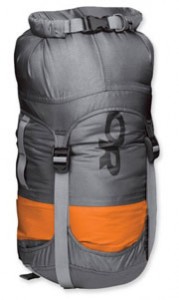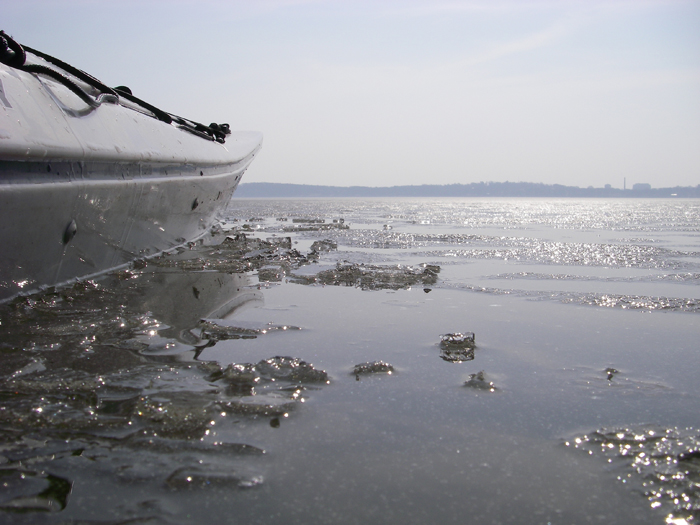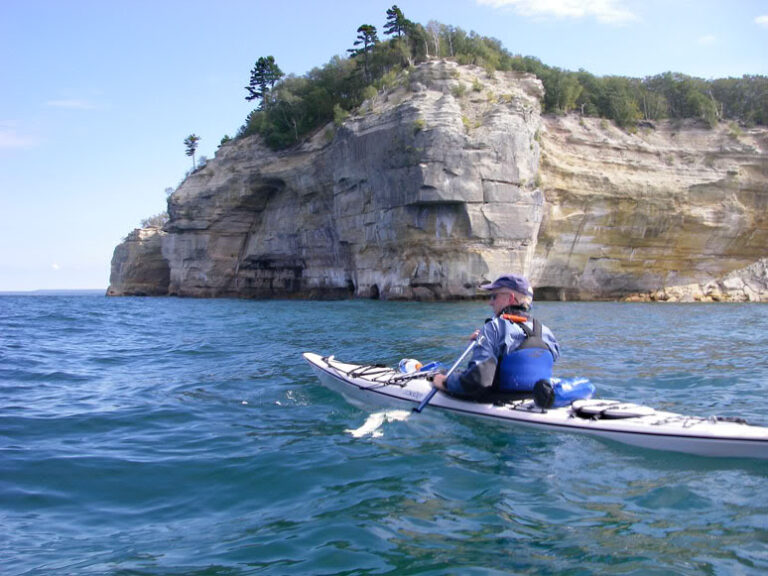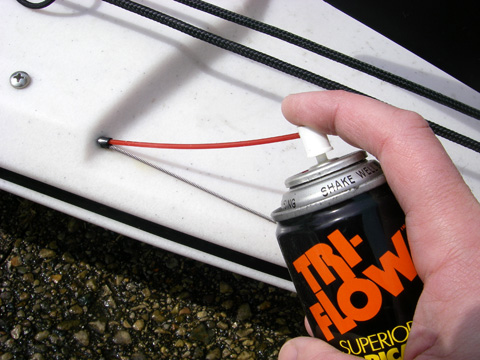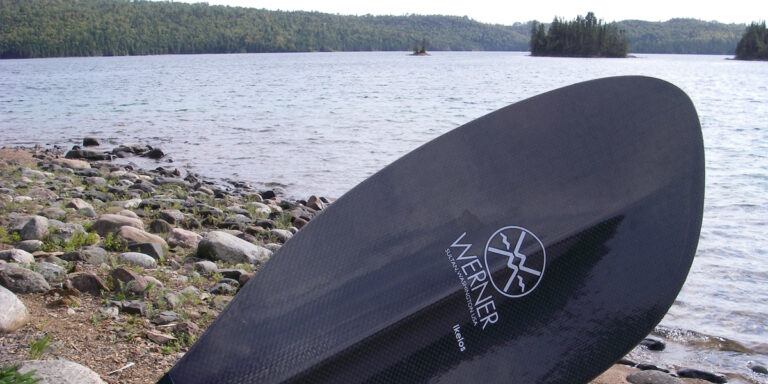What to Look for in a Sleeping Bag for Kayak-Camping
“The days are cold, the nights are long,
The North wind sings a doleful song”
Dorothy Wordsworth
After a long day on the water, a quality sleeping bag can make the difference between a good night’s sleep, and cold misery … In addition to all the usual considerations when selecting a sleeping bag for lightweight backcountry travel, sea-kayak tourers demand a few special characteristics: the bag must be able to accommodate a broad temperature range, maintain warmth even in the moisture and humidity inherent in a marine environment, and compact enough to fit in the hold of a sea kayak.
Following are some points to consider when choosing a sleeping bag for kayak-touring;
Sleeping Bag Temperature Ratings
Start shopping for a new sleeping bag, and you’ll soon notice references to comfort ratings: Summer, Three-Season, Winter, etc.. They may even boast specific temperature ranges, such as 20°F, or 40°F, for example. While these can be helpful in narrowing down your search and comparing one bag to another, it should be noted that there is presently no industry-wide standard for such ratings, and while some claims are quite accurate, others may be … well, a bit optimistic. So, it’s probably best to ere on the side of caution and look for a bag a bit warmer than you think you’ll need, especially if you tend to sleep ‘cold’. Also, sleeping bags are apt to slowly lose their insulative qualities through usage, so keep this in mind when making your choice.
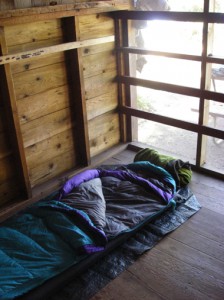
Other factors like your choice of sleeping pad, night clothes, personal metabolism and hydration levels, and shelter (tent, hammock, or none) all play a role in how warm a sleeping bag will be, and are addressed later.
Generally speaking, a Summer bag will be lighter in weight and more compact, while a Cold-weather bag will boast more insulation, and bulk and weight. A Three-Season sleeping bag will fall somewhere in between.
Summer-Weight
These lightweight, compact sleeping bags are generally designed to be comfortable for most people down to temperatures of 35°F. They usually offer full-length zippers so you can fling them open on balmy evenings, but lack few extra features. They’re intended to be a basic bedroll for the warmer camping seasons.
Three-Season
Offering a bit more insulation, these bags are intended for camping from early Spring all the way through to late Autumn, with the chilly nights those seasons entail; generally, 10°F to 35°F. Though heavier and more bulky, these bags often feature added insulation behind the zipper, an extended hood which the sleeper can cinch down for extra warmth, and other design characteristics to keep you warmer.
Cold-Weather
These sleeping bags, and their puffier extreme Winter-weight cousins, probably have little value for a sea-kayak tourer, except perhaps those hardy souls paddling Arctic waters. These are rated for temperatures from -10°F to +10°F, and their weight and bulk make them less well-suited to packing into the hold of a kayak. If, however, you indeed paddle in such conditions, or you believe the maker is over-rating the bag’s warmth, such a sleeping bag may be worth consideration.
Sign up for “Fetch,” the newsletter of Superior Paddling!
Be the first to know about new or featured how-to articles, product reviews, and destination trip reports, plus other sea-kayak events, news, and more.
Insulation Types
Broadly speaking, modern sleeping bags use one of two types of fill to provide their insulation: down or synthetic. Both offer advantages and drawbacks.
Down
This is the fuzzy undercoat in the feathers of geese and ducks. As with most things in Nature, it’s hard to improve upon down’s qualities: an exceptional weight-to-warmth ratio, and it is extremely compressible, making for a very warm, lightweight, and compact sleeping bag. These bags are often more expensive than their synthetic-fill counterparts, due to the scarcity of goose and duck down. Also, because the natural oils have been removed from the feathers during processing, down is very susceptible to moisture, and loses most of its insulating qualities when wet. It also takes forever to dry once wetted, so most quality down bags are made of a durable water repellent (DWR) finished fabric shell.
Touring paddlers may prefer down bags due to their light weight and diminutive packed size.
Synthetic
Usually made of long polyester fibers, this insulation is formed into loose clumps or batts, and contained within a fabric shell similar to down bags. Far less absorptive than goose down, polyester fill retains much more of its insulative qualities when damp, and is easily dried. It is also less expensive than down, though requires more bulk for similar warmth, and is less compressible, leading to a less-compact bag.
Touring paddlers may prefer synthetic-fill bags due to their water-resistance.
Bag Shapes
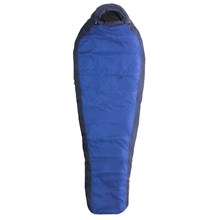
Sleeping bags, like paddlers themselves, come in a variety of shapes and sizes to suit different bodies and sleeping preferences.
Rectangular
Equally wide at the head as at the foot, rectangular sleeping bags are easier to manufacture, so are usually cheaper. They offer more foot room for campers who like to splay their feet while sleeping, though this extra space can be harder to keep warm. The additional material also comprises extra bulk and weight.
Semi-Rectangular
Similar to rectangular, but slightly tapered toward the foot to increase warmth efficiency and reduce weight.
Mummy
As the name implies, this bag is widest at the shoulders and elbows, and tapers to a narrower profile at the head and the foot, to more closely match the shape of the human body. This reduces the amount of empty space which must be warmed by body heat, making for a warmer bag. Some sleepers may find these bags a bit claustrophobic, but those who regard the mummy bag as a ‘sleeping garment’ which tosses and turns with you, find them a toasty way to sleep.
Choosing, Using, and Packing a Sleeping Bag for Kayak-Camping
The primary considerations when buying a new bag are your intended camping environment/temperature, the amount of space and weight you can accommodate in your kayak, followed by your own personal body shape, size, and metabolism. Finally, budget will certainly dictate your final choices. In general, it’s best to buy a bag that’s a little warmer, a little bigger, and a little more expensive than you might have planned.
All sleeping bags will be made warmer by use of a sleeping pad; closed-cell foam and self-inflating pads provide the best insulation, followed by inflatable air mattresses with integrated insulation layers. Uninsulated air mattresses are best suited to milder temperatures. A bag’s warmth can also be extended in colder seasons by use of a fabric liner, an optional inner bag made of a variety of materials such as polyester fleece or cotton. Many hikers and paddlers carry an extra set of fleece PJ top, bottom, and socks dedicated just for sleeping, and these help boost a bag’s comfort.
You should also consider the type of shelter you’ll be sleeping in. A snug tent which minimizes air flow will be the warmest, while a tarp, fly, or hammock can be chilly, and may require additional insulation or PJs.
All sleeping bags, regardless their type or size, are best packed in a kayak in a waterproof compression drybag. These minimize the bulkiness of the sleeping bag while underway, and protect the bag from the inevitable moisture of paddlesports and shoreline camping. To pack your sleeping bag, start by stuffing the foot of the bag into the compression drybag, and continue feeding the entire bag into it, gently squeezing as you go to avoid tearing the sleeping bag’s internal insulation baffles and seams. Close the drybag’s internal neck, then cinch down the external compression straps, working your way around the drybag until the bag is fully compressed; close the drybag’s rolltop closure to ensure a watertight seal.
When you arrive in camp and unpack the kayak, first set up your shelter and sleeping pad, then unpack your sleeping bag. Give it a few hearty but gentle shakes to loosen the fluffy insulation and increase its ‘loft’, then spread it out on your sleeping pad to let it further expand to its full size before bedtime.
Sleeping Bag Care
Keep your sleeping bag clean and dry, and protect it from skin oils by wearing some sort of pajamas, thermal underwear, or using a sleeping-bag liner. Periodically wash the bag according to the manufacturer’s instructions using a commercial soap made for your bag’s insulation type. Between camping trips, the sleeping bag should be stored in a cotton laundry bag, loosely folded to avoid compressing the insulation.
Considering that we kayak-tourers perhaps spend even more time in our sleeping bags than in our boats, the purchase and proper care of that bag is a wise investment in our health and physical comfort.
Sleep tight!
Additional Resources:
Sierra Trading Post’s “Sleeping Bag Guide”
“Sleeping bag comparison: down vs. synthetic”
REI’s “How to Choose a Sleeping Bag for Backpacking”
European Norm (EN) 13537 Requirements for Sleeping Bags
What do you think? Leave a question or comment below!



